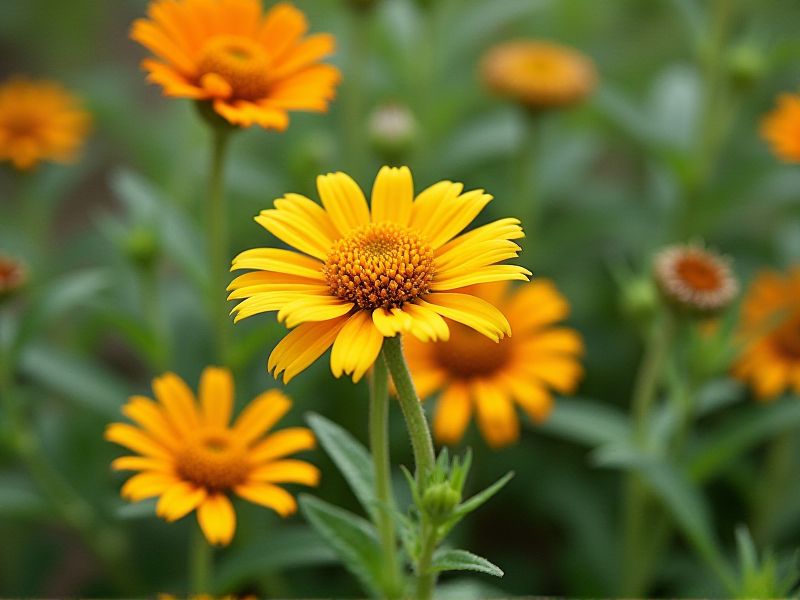
Drought-resistant plants, such as succulents, cacti, and certain varieties of native grasses, thrive in arid conditions and require minimal water to survive. These hardy plants have adapted various mechanisms, such as thickened leaves or deep root systems, to store moisture effectively. Examples include Agave, with its rosette form, and Lavender, known for its aromatic foliage. Incorporating these types of plants into your landscape not only conserves water but also creates a vibrant, low-maintenance garden. Consider selecting drought-tolerant perennials, like Echinacea or Sedum, to enhance both beauty and sustainability in your outdoor space.
List of some Hardy plants that resist drought
- Lavender (Lavandula)
- Rosemary (Rosmarinus officinalis)
- Agave (Agave americana)
- Sage (Salvia officinalis)
- Yucca (Yucca filamentosa)
- Sedum (Sedum spp.)
- Russian Sage (Perovskia atriplicifolia)
- Cacti (Various genera)
- Bougainvillea (Bougainvillea spp.)
- Oleander (Nerium oleander)
Important things about Hardy plants that resist drought
Definition Of Drought-Resistant Plants
Drought-resistant plants, often classified as hardy specimens, exhibit remarkable adaptations to thrive in arid conditions. These plants possess features such as deep root systems, fleshy leaves, and specialized storage tissues that enable them to conserve water efficiently. Examples include succulents like aloe vera and cacti, along with native grasses and shrubs that have evolved to withstand prolonged periods of low moisture. By incorporating drought-resistant plants into your garden, you can create a sustainable landscape that requires minimal irrigation while promoting biodiversity.
Adaptations To Arid Environments
Hardy plants, such as succulents and xerophytes, have evolved remarkable adaptations to thrive in arid environments characterized by low water availability. These plants often possess thick, fleshy leaves or stems that store moisture, allowing them to survive prolonged droughts. Their deep root systems enable them to access groundwater while specialized tactics, like water retention through waxy coatings, minimize evaporation. Understanding the resilience of these hardy species can enhance your ability to cultivate drought-resistant gardens, contributing to sustainable landscaping practices.
Types Of Drought-Resistant Plants
Drought-resistant plants, known for their resilience, thrive in arid conditions with minimal water. Some popular hardy varieties include succulents like agave and aloe, which store moisture in their leaves, making them perfect for dry landscapes. Native plants such as lavender and sage not only require little water but also attract pollinators, benefiting local ecosystems. Incorporating these drought-tolerant species into your garden can reduce water usage while maintaining vibrant, sustainable greenery.
Water Conservation Strategies
Hardy plants, such as succulents and native drought-resistant species, are essential for effective water conservation strategies in arid regions. These plants have developed unique adaptations, like thick, fleshy leaves and deep root systems, allowing them to store moisture and thrive with minimal water. Incorporating these resilient species in your garden not only reduces water consumption but also enhances biodiversity, attracting beneficial insects and pollinators. By selecting the right hardy plants, you can create a sustainable landscape that conserves water while maintaining aesthetic appeal.
Deep Root Systems
Hardy plants with deep root systems, such as desert succulents and certain native grasses, thrive in arid environments by accessing moisture far below the surface. These root systems can extend several feet into the ground, allowing them to tap into underground water sources during prolonged dry spells. Species like the Agave and the Deep-rooted native grasses are exemplary, showcasing adaptations that enhance survival and minimize water loss. By incorporating these drought-resistant plants into your garden, you can create a sustainable landscape that requires less irrigation and supports local biodiversity.
Leaf Structure And Size
Hardy plants that resist drought often feature specialized leaf structures that enhance water retention and minimize transpiration. These adaptations can include waxy coatings, reduced leaf surface areas, or spines that decrease water loss while still allowing photosynthesis. Typically, the leaves of these plants may appear smaller and thicker, allowing them to withstand arid conditions by storing moisture efficiently. Understanding these characteristics can help you select the most resilient plants for your garden, particularly in regions prone to drought.
Soil Requirements
Hardy plants that resist drought thrive in well-drained soils with good aeration, promoting healthy root development. These plants often prefer sandy or loamy soils enriched with organic matter, which enhances moisture retention without becoming waterlogged. To optimize growth, consider adding mulch to conserve soil moisture and prevent evaporation, creating a more stable environment for drought-resistant species. By choosing the right soil composition, you can ensure your hardy plants adapt effectively to varying climatic conditions.
Maintenance And Care
Hardy plants that resist drought, such as succulents, lavender, and ornamental grasses, are ideal for low-maintenance gardens. These resilient species have adaptations like thick leaves, deep root systems, and water-storing capabilities that allow them to thrive in arid conditions. Incorporating hardy plants not only reduces water consumption but also enhances landscape aesthetics with their diverse textures and vibrant blooms. By selecting drought-resistant varieties, you can create an eco-friendly garden that conserves resources while providing a beautiful outdoor space.
Climate Considerations
Hardy plants that resist drought, such as succulents, native grasses, and some perennial shrubs, are essential for sustainable gardening in arid regions. These plants have adapted to conserve water, utilizing deep root systems and thick, fleshy leaves to withstand extended periods of dryness. Notable examples include Agave, which requires minimal rainfall, and Lavender, known for its drought resilience and aromatic foliage. Incorporating these drought-resistant varieties in your landscape can enhance ecological balance while reducing water usage and maintenance needs.
Benefits For Sustainable Gardening
Hardy plants that resist drought are essential for sustainable gardening, providing numerous ecological benefits while minimizing water usage. These resilient species, such as lavender, sedum, and succulents, require less maintenance and significantly reduce the need for irrigation, making them ideal for arid climates. By incorporating drought-resistant plants into your garden, you not only conserve water but also create habitats that support local wildlife, including pollinators and beneficial insects. Choosing hardy plants enhances soil health as they typically possess deep root systems that improve soil structure and promote moisture retention.
